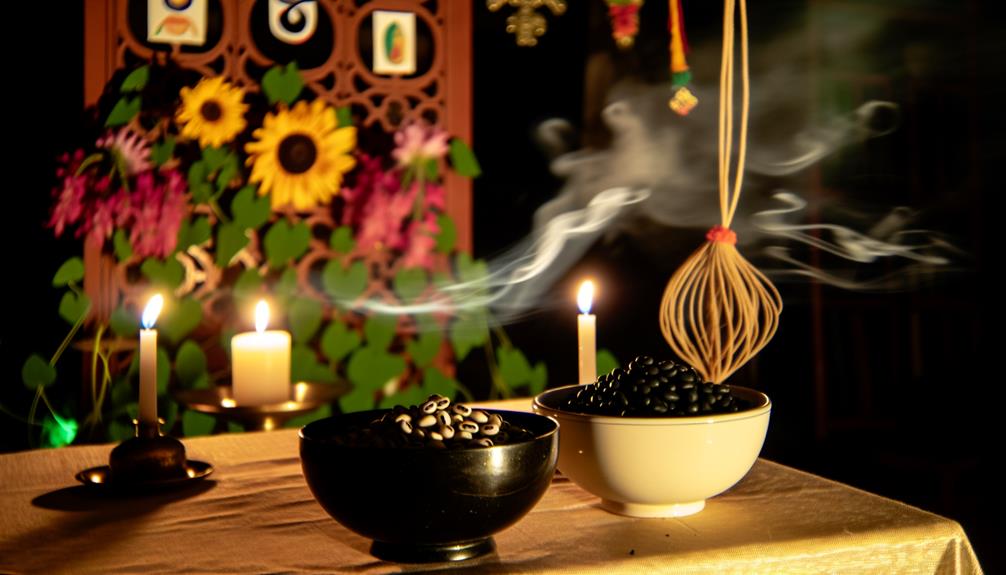Black Eyed Peas Spiritual Meaning: New Beginnings
The spiritual meaning of black-eyed peas holds deep cultural significance that spans continents and centuries. Originating from West Africa, these legumes symbolize prosperity, luck, and protection.
Integral to various cultural and spiritual practices, they are believed to ward off negative energies and misfortune. In African American traditions, consuming black-eyed peas on New Year’s Day is thought to bring financial prosperity and good fortune, often symbolizing coins.
Additionally, their use in rituals and offerings underscores their protective qualities against malevolent forces. From nutritional value to symbolic resonance, black-eyed peas encapsulate rich traditions and beliefs that continue to inspire.

Black Eyed Peas Spiritual Meaning: Symbolism of Prosperity, Protection, and New Beginnings
| Symbolism | Meaning |
|---|---|
| Prosperity and Luck | Attracts wealth and abundance, especially when eaten on New Year’s Day |
| Protection | Believed to ward off negative energy and bring spiritual safety |
| New Beginnings | Symbolizes renewal, fresh starts, and setting positive intentions |
| Humility and Gratitude | Encourages thankfulness and modesty in spiritual growth |
| Ancestral Connection | Tied to cultural heritage and honoring ancestral wisdom |
Origins of Black-Eyed Peas

Black-eyed peas, a staple in various global cuisines, trace their origins to West Africa where they have been cultivated for thousands of years. These legumes, scientifically known as Vigna unguiculata, thrive in arid climates, making them a resilient crop in African agriculture.
Historically, they played an essential role in sustaining communities due to their nutritional richness, including protein, fiber, and essential vitamins. The spread of black-eyed peas to other continents occurred primarily through the transatlantic slave trade, embedding them in the culinary traditions of the Americas and beyond.
Their adaptability to different soils and climates facilitated their global agricultural success, while their robust nutritional profile guaranteed their place in diverse diets, from soups to stews and beyond.
Symbolism in African Cultures
In African cultures, black-eyed peas hold profound symbolic significance, often representing prosperity, luck, and protection against adversity. This legume is more than a dietary staple; it embodies deep cultural and spiritual meanings.
Throughout various African societies, black-eyed peas are believed to ward off negative energies and safeguard individuals from misfortune. Their usage spans from ritualistic offerings to celebratory feasts, each context reinforcing their symbolic potency.
The black ‘eye’ in the center is particularly thought to possess protective qualities, acting as a sentinel against evil spirits. This protective symbolism is intricately woven into traditional ceremonies and daily practices, illustrating the beans’ integral role in the cultural and spiritual fabric of African communities.
Luck and Prosperity

The symbolic resonance of black-eyed peas extends beyond protection, intertwining deeply with notions of luck and prosperity in African cultural traditions. Historically, these legumes have been considered harbingers of good fortune and wealth.
Consuming black-eyed peas, particularly at the start of a new year, is believed to attract financial prosperity and success. This practice transcended continents, becoming integral to African American New Year’s customs, such as the iconic Southern dish, Hoppin’ John.
The circular shape of the peas symbolizes coins, reinforcing their connection to wealth. Furthermore, their resilience and ability to thrive in harsh conditions embody the tenacity and endurance necessary for achieving lasting prosperity.
Consequently, black-eyed peas serve as both a culinary delight and a spiritual talisman for luck.
Protection and Warding Off Evil
Black-eyed peas have long been revered for their protective qualities, with historical accounts documenting their use to ward off malevolent forces.
Their symbolism in various folklore traditions underscores their role as a talisman against evil, often integrated into rituals designed to safeguard individuals and homes.
These ritualistic applications highlight the deep-seated belief in the peas’ ability to create a barrier against harmful influences.
Historical Protective Uses
Throughout history, various cultures have imbued black-eyed peas with protective properties, using them as talismans to ward off evil and negative energies. These legumes were often part of rituals and practices aimed at safeguarding individuals and households.
For instance, in the American South, black-eyed peas are traditionally eaten on New Year’s Day to guarantee good luck and protection throughout the year. Similarly, in West African traditions, these peas were carried as amulets or scattered around homes to create a shield against malevolent forces.
| Culture/Region | Protective Use |
|---|---|
| American South | Consumed on New Year’s Day for luck and protection |
| West Africa | Carried as amulets or scattered to ward off evil |
| Ancient Egypt | Used in burial rituals to protect the deceased |
| Southern Europe | Incorporated in charms to safeguard against curses |
| Caribbean Islands | Employed in spiritual cleansings and protection rites |
Symbolism in Folklore
Intriguingly, many folklore traditions across diverse cultures emphasize the black-eyed pea‘s role in protection and warding off evil, often attributing mystical qualities to this humble legume.
In African American folklore, particularly within the Gullah culture, black-eyed peas are believed to possess the power to repel negative energies and malevolent spirits.
Similarly, in West African traditions, these legumes are seen as a safeguard against misfortune, often incorporated into protective charms and amulets.
The black spot on the pea is thought to resemble an all-seeing eye, a symbol of vigilance against evil forces.
This interpretation underscores a broader cultural motif in which everyday food items are revered not just for sustenance but also for their perceived spiritual and protective properties.
Ritualistic Applications
In many cultural rituals, black-eyed peas are strategically used to create protective barriers and ward off evil spirits, reflecting their deep-rooted symbolic significance.
This practice is prevalent in various traditions, where black-eyed peas serve as more than just a culinary staple. Their ritualistic applications span different contexts, each underscoring their perceived power to safeguard individuals and spaces.
- Household Protection: Sprinkling black-eyed peas around the home to shield against malevolent forces.
- Amulets: Using black-eyed peas in talismans or amulets believed to offer personal protection.
- Ritual Baths: Incorporating them in spiritual baths for cleansing and protection.
- Threshold Barriers: Placing them at doorways to prevent evil from entering.
These practices illustrate the profound cultural reverence for black-eyed peas as protective agents.
Role in Southern Traditions

In Southern traditions, black-eyed peas hold significant cultural and symbolic importance, particularly during New Year’s Day rituals.
Consumed as part of a traditional meal that includes greens and cornbread, these legumes are believed to bring prosperity and good fortune for the year ahead.
This custom underscores the broader Southern emphasis on symbolism and ritual as a means to influence one’s destiny.
New Year’s Day Rituals
A deeply rooted tradition in Southern culture, the consumption of black-eyed peas on New Year’s Day is believed to bring prosperity and good luck for the coming year. This ritual is not merely a culinary preference but a significant cultural practice imbued with historical and spiritual meaning.
The tradition typically encompasses several key elements:
- Preparation: Often cooked with ham hocks or bacon to add flavor.
- Accompaniments: Served alongside collard greens, cornbread, and pork.
- Timing: Consumed precisely at midnight or during the first meal of the day.
- Superstition: A minimum of 365 peas should be eaten, one for each day of the year.
These elements collectively reinforce the practice’s importance in Southern heritage.
Symbolism of Prosperity
Understanding the symbolism of prosperity associated with black-eyed peas in Southern traditions requires examining the cultural narratives and historical contexts that have imbued this humble legume with such significance.
Originating from African American culinary practices, black-eyed peas were considered a symbol of luck and financial abundance, particularly when consumed on New Year’s Day.
This tradition likely evolved during the Civil War, when Union soldiers left behind only black-eyed peas and salted pork, which then became sustenance for Southern communities.
Over time, eating black-eyed peas on New Year’s Day has come to represent a fresh start and the hope for prosperity.
This enduring practice underscores the rich interplay between cultural heritage and the quest for economic well-being in Southern society.
New Year’s Day Customs
As the clock strikes midnight on New Year’s Day, many households across various cultures prepare and consume black-eyed peas, believing that this tradition will bring prosperity and good fortune for the year ahead.
This custom is steeped in historical and cultural significance, reflecting a collective hope for future abundance. The practice involves various symbolic elements that enhance its perceived efficacy:
- Hoppin’ John: A Southern United States dish combining black-eyed peas, rice, and pork.
- Coin-Like Shape: The peas symbolize coins, reinforcing the theme of wealth.
- Collard Greens: Often served alongside, representing money.
- Cornbread: Its gold color signifies wealth.
Understanding these customs provides insight into how cultural rituals shape collective aspirations for prosperity.
Rituals and Offerings

Rituals and offerings involving black-eyed peas are deeply embedded in cultural and spiritual practices, symbolizing a conduit for attracting prosperity and warding off negative influences.
In various traditions, these legumes are prepared and consumed during significant events such as the New Year, to invoke good fortune. Symbolically, the peas represent coins, and their consumption is believed to bring financial stability.
In addition, in some African and Southern U.S. communities, they are used in altars and offerings to deities or ancestors, signifying a gesture of respect and a plea for blessings.
These practices demonstrate a profound belief in the inherent spiritual properties of black-eyed peas, reflecting a cultural tapestry rich with historical and mystical significance.
Health Benefits and Symbolism
In addition to their cultural and spiritual significance, black-eyed peas offer numerous health benefits that underscore their symbolic representation of prosperity and well-being.
Rich in essential nutrients, these legumes are a powerhouse of dietary advantages. Black-eyed peas are known to support heart health, improve digestive function, and help regulate blood sugar levels, making them a valuable addition to any diet.
- Rich in Fiber: Aids in digestive health and promotes satiety.
- High in Protein: Supports muscle repair and overall growth.
- Low Glycemic Index: Helps in managing blood sugar levels.
- Packed with Antioxidants: Protects against cellular damage.
These attributes highlight the profound connection between their health benefits and their symbolic meanings.
Modern Spiritual Practices

Beyond their nutritional benefits, black-eyed peas have found a place in modern spiritual practices, where they continue to be revered for their symbolic power and are integrated into various rituals and meditative activities.
In contemporary settings, these legumes are often used in New Year’s traditions to invoke prosperity and good fortune. Within meditative practices, black-eyed peas serve as focal points for mindfulness exercises, symbolizing renewal and grounding.
Additionally, many spiritual practitioners incorporate them into altars and sacred spaces as emblems of protection and abundance. This modern appropriation reflects an enduring belief in their mystical properties, highlighting a seamless blend of ancient wisdom and contemporary spiritual expression.
The black-eyed pea consequently maintains its relevance across diverse cultural and spiritual landscapes.
Conclusion
The multifaceted spiritual significance of black-eyed peas spans continents and centuries, embodying themes of luck, prosperity, protection, and cultural continuity.
Rooted deeply in African traditions and seamlessly integrated into Southern customs, these legumes serve not only as a culinary staple but also as a symbolic offering in various rituals.
Their enduring presence in modern spiritual practices underscores their integral role in the tapestry of cultural heritage.
Essentially, black-eyed peas are more than meets the eye, encapsulating a rich legacy of spiritual and cultural symbolism.






